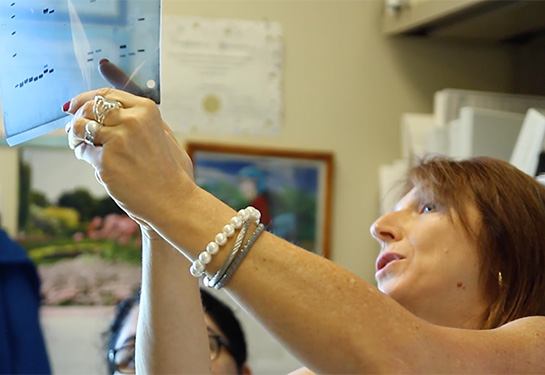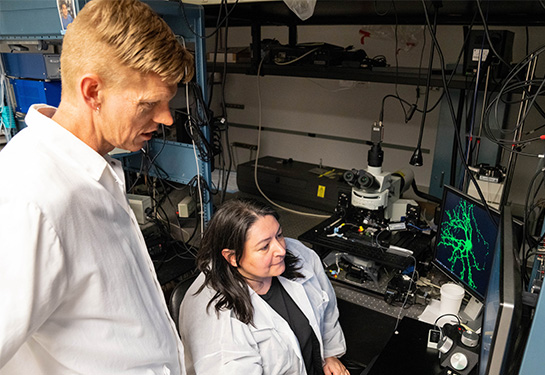Are biopsies needed in pediatric and young adult patients with lymph node metastases?
A new analysis, led by UC Davis pediatric oncologist Elysia Alvarez, better defines the clinical features and outcomes of young patients with non-rhabdomyosarcoma soft tissue sarcoma (NRSTS) with regional and distant lymph node (LN) metastases. The patients were part of a study led by Children’s Oncology Group, a National Cancer Institute-supported clinical trials group.
NRSTS is a heterogeneous group of tumors varying in histologic appearance and clinical behavior that represent about 4% of childhood cancers. Although most pediatric patients with NRSTS have localized disease and relatively good outcomes, those with metastatic disease fare poorly.
Researchers found that nodal recurrence was uncommon in young NRSTS patients with nodal metastases who received protocol-specified surgery and radiotherapy, documenting the efficacy of this approach for future patients.
The findings were published recently in the European Journal of Cancer.
The analysis of patients with lymph node metastases comes from the largest prospective clinical trial of pediatric and young adult NRSTS in North America conducted by the Children’s Oncology Group.
“To our knowledge, this is the only study ever conducted worldwide to include robust central review of pathology specimens and diagnostic imaging studies, thereby enabling us to carefully document the clinical features of these cases and make practice-changing recommendations related to lymph node involvement and its management,” said Alvarez, who was the first author of the study.
Evaluating a risk-based treatment strategy for young patients with all stages of NRSTS
The analysis included 529 eligible patients under the age of 30 with newly diagnosed NRSTS and LN metastases. All were enrolled in the Children’s Oncology Group study between February 2007 and February 2012. Of this entire cohort, 104 patients had LN procedures. Twenty patients (3.8%) had LN metastases at study entry. All had radiologic evidence of LN involvement except for one patient.
Thirteen of the 20 patients with LN metastases had histologic confirmation (two core biopsy, two incisional biopsy, six enlarged LN resection, and three formal LN dissection); the remaining seven had LN involvement confirmed by central imaging review.
This study found that LN metastases occur in about 4% of pediatric and young adult patients with NRSTS. Patients with LN metastases had larger tumors, a higher incidence of distant metastases and more often had unresected tumors at study entry than those without LN metastases. The diagnoses most associated with LN metastases (over 10%) were epithelioid sarcoma, clear cell sarcoma and angiosarcoma.
Patients with isolated LN involvement fared significantly better than those who had extranodal metastases, with outcomes similar to those with non-metastatic disease. A better prognosis had not been documented for pediatric patients with isolated LN metastases previously.
“Utilizing detailed guidelines for lymph node assessment and central review of diagnostic imaging, operative notes, and pathology specimens and reports, we found that occult lymph node involvement is exceedingly rare,” Alvarez said. “We therefore recommend a change in clinical practice to eliminate routine lymph node biopsies except for those with clinical or radiographic evidence of lymph node involvement by tumor.”
Eliminating lymph node sampling may improve outcomes by accelerating initiation of other therapy, reducing anesthesia risks in young children, lowering the risk of postoperative complications, and decreasing overall costs.
Study authors note that the main limitation of this analysis is the small number of patients with LN metastases, which limits the reliability of conclusions.
“Although our numbers are small, we believe that our findings suggest that young patients with isolated nodal involvement should be treated with curative intent,” Alvarez said.
The Children’s Oncology Group study was led by pediatric oncologist Sheri Spunt of Stanford University’s School of Medicine. Other authors of this publication are Jiayi He, David Parham and Donald Barkauskas, of the University of Southern California’s Keck School of Medicine; Sheri Spunt and Lynn Million, of Stanford University’s School of Medicine; Andrea Hayes-Jordan, of the University of North Carolina; Simon Kao, of the University of Iowa’s Carver College of Medicine and Aaron Weiss, of Maine Medical Center.
The study received funding from Children’s Oncology Group Chair’s Grant U10CA098543; Children’s Oncology Group Statistics and Data Center Grant U10CA098413; Quality Assurance Review Center Grant U10CA29511; Imaging and Radiation Oncology Core grant U10CA180803; NCTN Operations Center Grant U10CA180886; NCTN Statistics & Data Center Grant U10CA180899; St. Baldrick’s Foundation; Seattle Children’s Foundation (from Kat’s Crew Guild through the Sarcoma Research Fund); the Solid Tumor Program Project Grant P01CA23099, Cancer Center Support CORE Grant P30CA21765, and the American Lebanese Syrian Associated Charities.




